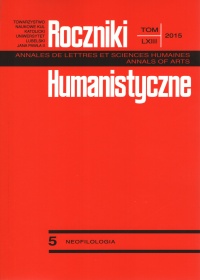The Game of the Same and the Other: Guy de Maupassant’s The Horla, a Twofold Story in Two Versions
Abstract
The Horla, written twice, is considered as a masterpiece of a short horror story. Its two versions are still objects of critics’ arguments : some of them see in the second text an amplified and revised version of the first one, whereas others consider the two texts as two separate stories. The paper tries to consider the two Horlas as two complementary parts of the same story ; the first is told by a completely ‘normal’ person who has asked to live in a lunatic asylum, and the second, full of striking, strong emotions, is given by someone who gives up more and more to mental troubles caused by his fear of the unknown, the unnamed, the invisible. Considered in this way, the texts of the two versions of The Horla become one “autoscopic” story, which means that it is its own reflect; two narrative lines and two different endings deal with two sides, one rational ant the other irrational, of the narrator’s personality. This dualism comes as well from the writer’s biography (his gradual insanity) as from his time’s fascination of mental illnesses and anomalies.
References
Fonyi, Antonia. « Dossier de lecture ». Dans Guy de Maupassant. Le Horla et autres contes d’angoisse, 233–249. Paris : Flammarion, 1984.
Fonyi, Antonia. « Introduction ». Dans Guy de Maupassant. Le Horla et autres contes d’angoisse, 5–32. Paris : Flammarion, 1984.
Gros, Frédéric. Création et folie. Une historie du jugement psychiatrique. Paris : PUF, 1997.
Kopaliński, Władysław. Słownik symboli. Warszawa : Wiedza Powszechna, 1990.
Lacan, Jacques. Le stade du miroir comme formateur de la fonction du Je. Dans Écrits. Paris : Seuil, 1966.
Lanoux, Armand. Maupassant le bel-ami. Paris : Fayard 1967.
Maupassant, Guy de. Le Horla [1ère version]. Dans Guy de Maupassant. Le Horla et autres contes d’angoisse, 43–52. Paris : Flammarion, 1984.
Maupassant, Guy de. Le Horla [2e version]. Dans Guy de Maupassant. Le Horla et autres récits fantastiques, 115–141. Paris : Presses Pocket 1989.
Maupassant, Guy de. Lettre d’un fou. Dans Guy de Maupassant. Le Horla et autres contes d’angoisse, 35–41. Paris : Flammarion 1984.
Maupassant, Guy de. Madame Hermet. Dans Guy de Maupassant. Contes et nouvelles, t. II, 1606–1607. Paris : Gallimard, 1979.
Maupassant, Guy de. Solitude. Dans Guy de Maupassant. Monsieur Parent, 281–287. Paris : Ollendorff 1886.
Morin, Edgar. Le Vif du sujet. Paris : Seuil, 1982.
Mortier, Daniel. « Dossier de lecture ». Dans Guy de Maupassant. Le Horla et autres récits fantastiques, 173–208. Paris : Presses Pocket, 1989.
Mortier, Daniel. Préface. Dans Guy de Maupassant. Le Horla et autres récits fantastiques, 5–11. Paris : Presses Pocket, 1989.
Rigoli, Juan. Lire et délire. Aliénisme, rhétorique et littérature en France au XIXe siècle. Paris : Fayard, 2001.
Rougé, Daniel. Écrire et lire la folie. Rencontrer le fou dans ses textes. Kraków : Wydawnictwo Naukowe Uniwersytetu Pedagogicznego, 2012.
Schmidt, Albert-Marie. Maupassant par lui-même. Paris : Seuil, 1962.
Schopenhauer, Arthur. Le Monde comme Volonté et comme Représentation. Traduit en français par Auguste Burdeau. Paris: Librairie Félix Alcan, 1912.
Todorov, Tzvetan. Introduction à la littérature fantastique. Paris : Seuil, 1970.
Togeby, Knud. L’œuvre de Maupassant. Copenhague, Paris : Danish Science Press, PUF, 1953.
Copyright (c) 2015 Roczniki Humanistyczne

This work is licensed under a Creative Commons Attribution-NonCommercial-NoDerivatives 4.0 International License.





